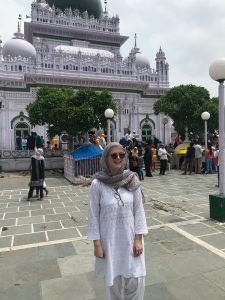دوران ماه پسش من در شهر لکهنو زندگی کرده ام برای یاد گرفتن زبان فارسی.نام برنام
من موسسه آمریکایی مطالعات هند است. این شهر زیبا مهمترین مرکز فرهنگ فارسی هند
بود دوران صد هجدهم نوزدهم و بیست و یکم . امروزه وقتی که مردم صحبت می کنند در
برای تذهیب لکهنو همیشه گفته است که این تمدن باقی مانده از گذشته است. ولی تجربه ام
اثبات زندگانی فارسی هند است .
در فضا ماحول شهر لکهنو بسیار گوهرها معماری هستند . من در باغها و گلزارش
سرگرداه و در خیابان هایش آواره بوده ام . خصوصیات و جالبت این شهر این است که در
به هر گوشه ای شهر قدیمی یک نو ساختمان تاریخی در نظر می آمد . غالبا آنها نادیده
گرفته شده اند یا فراموش شده اند . اما هنوز زیبا و قشنگ هستند , و بیشتر از آن, شاهدان
زمان پیش هستند.
میراث معماری شهر لکهنو دو نهاد مهم می ده : نوع اول داد گاه ها زمان ا مغالها و واجد
علی شاه , و نوع دوم خانقاه ها پیر صوفیان هستند . این دو نهاد گسترشگرها زبان فارسی
در هند بودند . امروزه به آنجا دید و بازدید کردن این رسم و رواج واضح است .
در درگاه کاکوری شریف , بفاصله چهارده کیلومتر از لکهنو , دیوار ها در آرامگاه تزئین
به اشعاری هم فارسی و اردو شده اند . خدمتگر نگاهدار آرامگاه به زبان فارسی با ما
صحبت می کرد . موسیقی قولی یک مهمترین و خصوص مراسم این منطقه هست .این
سنت آواز خواندن قلام و دیوان پیرها صوفی در هند متولد شد . به این وسیله پیام پیام یشان
به طور در سراسر شمال هند گسترش یافت . در کلاس ها من ما غزلها ها شاعران مثل امر
خسرو , یک سوفی قرون وسطایی مهم , می خوانیم . قول ها شعری او را خواندند در
آرامگاه ها در و نزدیک از شهر مثل دیوا شریف بفاصله سی و نه کیلومتر از لکهنو .
. برای من یک
تجربه بی نظیر است که من در این محل خاص این زبان را یاد می گیرم .

Dewa Sharif
English:
For the past month, I have been living in the city of Lucknow to
study the Persian language. The name of my program is the
American Institute of Indian Studies. This beautiful, extremely
important city was a centre of Indo-Persian culture during the
18th, 19th and 20th centuries. Today when people talk about the
culture and civilization of Lucknow, it is sad that this civilization is
but a remnant of the past. But my experience is evidence of the
fact that Indian Persian is quite alive.
In the spatial environment of the city of Lucknow, there are many
architectural gems. I have wandered in its lush gardens and been
lost in its streets. The special quality of interest in this city is the
fact that on every corner of its Old City, a new historical building
comes into view. Often they are ignored or forgotten. But still,
their sheer beauty remains, and more than that, they are
witnesses to bygone eras
The architectural heritage of the city of Lucknow gives us two
important institutions: the first type is the courts of the Mughal age
and Wajid Ali Shah, and the second type is the khanqas
(gathering spaces) of the Sufi peers (wise men). These two
institutions served as propagators and promoters of the Persian
language in North India.
In the dargah (shrine) of Kakori Sharif, at a distance of around 14
kilometers from Lucknow, the walls of each shrine are decorated
with both Persian and Urdu poetry. The caretakers and keepers of
the shrine spoke to us in Persian. Qawwali music is an extremely
important and special tradition of this region. This tradition of
singing the collected poetic works of Sufi saints was born in India.
In this way, their message was transmitted across all of North
India. In my classes, we read the poetry of poets like Amir
Khusro, an important Sufi of medieval times. Qawwals (singers of
Qawwali) sing his poetry at shrines in and around the city, like
Dewa Sharif, about 39 kilometers from Lucknow.
For me, it’s an incomparable experience that I am studying this
language in this special environment
